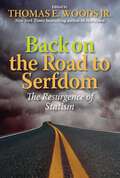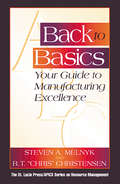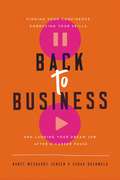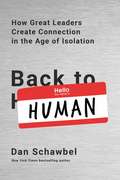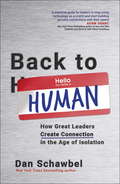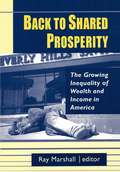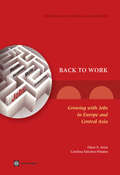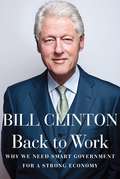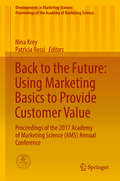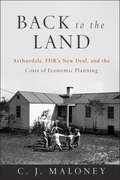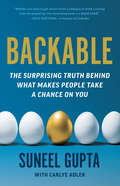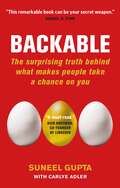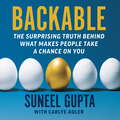- Table View
- List View
Back on the Road to Serfdom: The Resurgence of Statism
by Thomas E. Woods Jr.Leviathan is back The threat of statism has reemerged in force. The federal government has radically expanded its power—through bailouts, &“stimulus&” packages, a trillion-dollar health-care plan, &“jobs bills,&” massive expansions of the money supply, and much more. But such interventionism did not suddenly materialize with the recent economic collapse. The dangerous trends of government growth, debt increases, encroachments on individual liberty, and attacks on the free market began years earlier and continued no matter which political party was in power. This shift toward statism &“will not end happily,&” declares bestselling author Thomas E. Woods. In Back on the Road to Serfdom, Woods brings together ten top scholars to examine why the size and scope of government has exploded, and to reveal the devastating consequences of succumbing to the statist temptation. Spanning history, economics, politics, religion, and the arts, Back on the Road to Serfdom shows: · How government interventionism endangers America&’s prosperity and the vital culture of entrepreneurship · The roots of statism: from the seminal conflict between Thomas Jefferson and Alexander Hamilton to the vast expansion of federal power in the twentieth century · Why the standard explanation for the recent economic crisis is so terribly wrong—and why the government&’s frenzied responses to the downturn only exacerbate the problems · Why the European welfare state is not a model to aspire to but a disaster to be avoided · How an intrusive state not only harms the economy but also imperils individual liberty and undermines the role of civil society · The fatal flaws in the now-common arguments against free markets and free trade · How big business is helping government pave the road to serfdom · Why the Judeo-Christian tradition does not demand support for the welfare state, but in fact values the free market · How the arrogance of government power extends even to the cultural realm—and how central planning is just as inefficient and destructive there It&’s been more than sixty-five years since F. A. Hayek published his seminal work The Road to Serfdom. Now this impeccably timed book provides another desperately needed warning about—and corrective to—the dangers of statism.
Back to America: Identity, Political Culture, and the Tea Party Movement (Anthropology of Contemporary North America)
by William H. WestermeyerBack to America is an ethnography of local activist groups within the Tea Party, one of the most important recent political movements to emerge in the United States and one that continues to influence American politics. Though often viewed as the brainchild of conservative billionaires and Fox News, the success of the Tea Party movement was as much, if not more, the result of everyday activists at the grassroots level. William H. Westermeyer traces how local Tea Party groups (LTPGs) create submerged spaces where participants fashion action-oriented collective and personal political identities forged in the context of cultural or figured worlds. These figured worlds allow people to establish meaningful links between their own lives and concerns, on the one hand, and the movement&’s goals and narratives, on the other. Collectively, the production and circulation of the figured worlds within LTPGs provide the basis for subjectivities that often nurture political activism. Westermeyer reveals that LTPGs are vibrant and independent local organizations that, while constantly drawing on nationally disseminated cultural images and discourses, are far from simple agents of the larger organizations and the media. Back to America offers a welcome anthropological approach to this important social movement and to our understanding of grassroots political activism writ large.
Back to Basics: Your Guide to Manufacturing Excellence (Resource Management)
by Steven A. Melnyk R. T. ChristensenAs organizations move into the future, the operations environment needs to expand into Collaborative Planning and Forecast Replenishment (CPFR), Vendor Managed Inventory (VMI), and an Enterprise Resource Planning (ERP) operating system to become and remain competitive. These innovative and complex methods require an unprecedented degree of accuracy
Back to Beer...and Hockey: The Story of Eric Molson
by Helen AntoniouTo most Canadians, the Molson name is part of the very fabric of Canada. Since 1786, when John Molson founded his first brewery in Montreal, it has become synonymous with beer, hockey, and philanthropy. Few realize, however, how close the family came in recent years to losing control of the enterprise. Back to Beer...and Hockey offers intimate details of the life and work of Eric Molson, who not only saved the company, but positioned it to thrive as a global brewery into the twenty-first century. <p><p> With unprecedented access to the Molson family, Helen Antoniou traces Eric Molson’s evolution from a young brewmaster captivated by the chemistry of beer-making to chairman of Molson. Quiet by nature, he had to confront big egos, navigate complex boardroom politics, and even battle a disruptive cousin who tried to push him out of the way. Antoniou's carefully researched account details how the introverted Eric overcame his aversion to conflict to take the company from a failing conglomerate back to its core business of beer, eventually turning it into one of the world's leading brewers. Today, he has passed the torch to his sons, the seventh generation, but his steadfast vision prevails. <p> An absorbing account of one man's struggle at the helm of an international brewing giant, Back to Beer...and Hockey shows how Eric Molson’s guiding principles influenced the future of Molson – both the enterprise and the family.
Back to Business: Finding Your Confidence, Embracing Your Skills, and Landing Your Dream Job After a Career Pause
by Sarah Duenwald Nancy McSharry JensenThe 45 percent of American women who take career breaks know better than anyone that searching for a job—with its new modes of communication, new rules of discoverability, and new expectations—has changed rapidly in the last decade. This book lays out a clear path for anyone ready to re-enter the workforce.On the job hunt? Don&’t just polish your resume—you better make sure your LinkedIn profile is updated. And, if you aren&’t getting responses from recruiters, chances are it&’s, because the robots aren&’t selecting your profile because it's missing pertinent keywords. And, by the way, dress codes have changed and you&’ll need to know new technologies such as Slack and Google+ Hangouts. Got it? For many women re-entering the workforce after a career break, the job search world is a disorienting, confusing, and overwhelming place. Getting started is much easier when you know what the first step should be.In Back to Business, career coaching and re-entry experts Nancy McSharry Jensen and Sarah Duenwald have put together a guide for women returning to the workplace.Easy to understand and easy to put into practice, Back to Business teaches you how to: Identify and talk about what you want, taking into account what you&’ve been up to while on break. Understand your personal brand, both in-person and online, and how your skills translate to the career you are looking for. Become professionally relevant and gain confidence in your ability to return to the paid workforce. Look for job opportunities while being productive and intentional with your time. The authors understand through first-hand experience the anxiety of returning to work. They have helped hundreds of women facing the job search process to overcome the anxiety of what is often overwhelming life change.
Back to Human: How Great Leaders Create Connection in the Age of Isolation
by Dan SchawbelBack to Human explains how a more socially connected workforce creates greater fulfillment, productivity, and engagement while preventing burnout and turnover. New York Times bestselling author Dan Schawbel guides the next generation of leaders to create a workplace where teammates feel genuinely connected, engaged, and empowered to grow strong interpersonal skills rather than relying on technology. Based on Schawbel's exclusive research studies--featuring the perspectives of over 2,000 managers and employees across different age groups and from the US, UK, China, India, Brazil and other countries--Back to Human reveals why electronic and virtual communication, though vital and useful, actually contributes to a stronger sense of isolation at work than ever before. The corporate cultures we are experiencing right now need to change, and Schawbel offers a new leadership model featuring The Work-Life Balance Myth (we should consider work-life integration instead, which creates more synergies between all areas of your life and puts you in control of how you allocate your time), Shared Learning (how sharing knowledge allows you to stay relevant despite industry disruptions), and more. The book includes:Interviews with 100 leaders from notable companies including Facebook, Honeywell, HBO, Starbucks, General Mills, GE, Nike, American Express, Four Seasons, Walmart, TIME, LinkedIn, and The U.S. Air Force.A self-assessment called "The Work Connectivity Index" that measures that strength of team relationships.Exercises, examples and activities that readers can work on individually, or as a team, which will help them improve their leadership skills.Tips and strategies on how to increase personal productivity, be more collaborative and become more fulfilled at work.
Back to Human: How Great Leaders Create Connection in the Age of Isolation
by Dan SchawbelBack to Human explains how a more socially connected workforce creates greater fulfillment, productivity, and engagement while preventing burnout and turnover. New York Times bestselling author Dan Schawbel guides the next generation of leaders to create a workplace where teammates feel genuinely connected, engaged, and empowered to grow strong interpersonal skills rather than relying on technology. Based on Schawbel's exclusive research studies--featuring the perspectives of over 2,000 managers and employees across different age groups and from the US, UK, China, India, Brazil and other countries - Back to Human reveals why electronic and virtual communication, though vital and useful, actually contributes to a stronger sense of isolation at work than ever before. The corporate cultures we are experiencing right now need to change, and Schawbel offers a new leadership model featuring The Work-Life Balance Myth (we should consider work-life integration instead, which creates more synergies between all areas of your life and puts you in control of how you allocate your time), Shared Learning (how sharing knowledge allows you to stay relevant despite industry disruptions), and more. The book includes:-Interviews with 100 leaders from notable companies including Facebook, Honeywell, HBO, Starbucks, General Mills, GE, Nike, American Express, Four Seasons, Walmart, TIME, LinkedIn, and The U.S. Air Force.-A self-assessment called "The Work Connectivity Index" that measures that strength of team relationships.-Exercises, examples and activities that readers can work on individually, or as a team, which will help them improve their leadership skills.-Tips and strategies on how to increase personal productivity, be more collaborative and become more fulfilled at work.
Back to Shared Prosperity: The Growing Inequality of Wealth and Income in America
by Ray MarshallTo what extent are major social and political problems caused by basic income and unemployment trends? Is it possible to restore the kind of broadly shared prosperity the U.S. once experienced before the early 1970s? Some of the top economists of our time address these critical questions.
Back to Work
by Erwin R. Tiongson Indhira Santos Omar S. Arias María E. Dávalos Carola Gruen Gady Saiovici Carolina Sánchez-Páramo Cesar A. Cancho Natasha de Andrade FalcãoOver the last decade, significant global and regional forces including changes in technology, trade patterns, and business practices, with a steady shift in value added production and employment toward knowledge-intensive activities and services such as finance, the hospitality industry, and the retail trade, have been affecting the production and occupational structures of most developed economies. Many countries of Eastern Europe and Central Asia have also experienced ongoing exposure to international product and labor markets, some via integration with the European Union (EU), and in general experiencing more international competition and labor migration. The acceleration of growth, the easy access to credit during the financial boom, and improvements in business and labor regulations in some countries boosted labor demand. On the supply side, key factors in some countries included shifts in labor force participation rates, cross-border migration, and changes in social benefits that may have affected work incentives. With the sudden shock of the 2008 international financial crisis and its prolonged after-effects, all countries in the region are being forced to reassess their position in the international checkerboard, also in light of looming demographic trends and competing social demands. All countries will have to consider reforms to improve the quality of the business climate, make labor markets more competitive, modernize the public sector, deepen financial development, and increase integration in global markets are a necessary condition for positive and sustained employment creation. These efforts will have to be comprehensive and sustained for the payoff to materialize, as illustrated by the experience of the advanced reformers in the region. Moving along the modernization path will require further economic restructuring and labor reallocation, which can become a wasteful and inefficient process with significant short-term welfare losses among specific groups of workers, unless it is accompanied by policies aimed at improving the match between jobs and workers and enhancing the employability of those people who are most affected by the changes. Policies that are sensitive to age and gender can help increase the efficiency and effectiveness of the restructuring process.
Back to Work: Why We Need Smart Government for a Strong Economy
by Bill Clinton&“I wrote this book because I love my country and I'm concerned about our future,&” writes Bill Clinton. &“As I often said when I first ran for President in 1992, America at its core is an idea—the idea that no matter who you are or where you're from, if you work hard and play by the rules, you'll have the freedom and opportunity to pursue your own dreams and leave your kids a country where they can chase theirs.&” In Back to Work, Clinton details how we can get out of the current economic crisis and lay a foundation for long-term prosperity. He offers specific recommendations on how we can put people back to work and create new businesses, increase bank lending and corporate investment, double our exports, and restore our manufacturing base. He supports President Obama&’s emphasis on green technology, saying that change in the way we produce and consume energy is the strategy most likely to spark a fast-growing economy and enhance our national security. Clinton also says that we need both a strong economy and a smart government working together to restore prosperity and progress. He demonstrates that whenever we&’ve given in to the temptation to blame government for our problems, we&’ve lost our commitment to shared prosperity, balanced growth, financial responsibility, and investment in the future. That has led our nation into trouble because there are some things we have to do together. For example, he says, &“Our ability to compete in the twenty-first century is dependent on our willingness to invest in infrastructure: we need faster broadband, a state-of-the-art national electrical grid, modernized water and sewer systems, and the best airports, trains, roads, and bridges. &“There is no evidence that we can succeed in the twenty-first century with an antigovernment strategy,&” writes Clinton, &“with a philosophy grounded in &‘You&’re on your own&’ rather than &‘We&’re all in this together.&’&” Clinton believes that conflict between government and the private sector has proved to be remarkably good politics, but it has produced bad policies, giving us a weak economy with few jobs, growing income inequality and poverty, and a decline in our competitive position. In the real world, cooperation works much better than conflict, and &“we need victories in the real world.&”
Back to the Drawing Board: Designing Corporate Boards for a Complex World
by Jay W. Lorsch Colin B. CarterBusiness scandals from Enron to WorldCom have escalated concerns about corporate governance into a full-blown crisis. Institutional investors and legislators have dominated the debate and enacted important changes in corporate accounting and other areas. But Colin B. Carter and Jay W. Lorsch say that we must now focus on the performance of corporate boards. This timely book argues that boards are being pressed to perform unrealistic duties given their traditional structure, processes, and membership. Carter and Lorsch propose a strategic redesign of boards--making them better attuned to their oversight, decision-making, and advisory roles--to enable directors to meet 21st century challenges successfully. Based on the authors' deep expertise and longtime experience working with boards around the world, and on a probing survey of CEOs, Carter and Lorsch help boards to develop a realistic value proposition customized to the company they serve. The authors explore the core dilemmas and responsibilities boards face and outline a framework for designing the most effective structure, makeup, size, and culture. This book provides a candid account of the current state of boards and points the way in a time of crisis and change.
Back to the Future Postwar Reconstruction and Stabilization in Lebanon
by Sena Eken Thomas HelblingA report from the International Monetary Fund.
Back to the Future: Proceedings Of The 2017 Academy Of Marketing Science (ams) Annual Conference (Developments In Marketing Science: Proceedings Of The Academy Of Marketing Science Ser.)
by Nina Krey Patricia RossiThis proceedings volume presents timely research and insights on the advancement of marketing's basic premise--providing greater levels of customer value. In recent years, both marketing scholars and practitioners have witnessed great advancements in technology and methodologies associated with big data, with location-based marketing centered on mobile apps and the real-time tracking of consumer behavior, and with innovations and enhancements in communications utilizing the continually growing presence of social media. Featuring the full proceedings of the 2017 Academy of Marketing Science (AMS) Annual Conference held in Coronado Island, California, this volume provides ground-breaking research from scholars and practitioners from around the world that will help marketers in providing value for companies, consumers and society. Founded in 1971, the Academy of Marketing Science is an international organization dedicated to promoting timely explorations of phenomena related to the science of marketing in theory, research, and practice. Among its services to members and the community at large, the Academy offers conferences, congresses, and symposia that attract delegates from around the world. Presentations from these events are published in this Proceedings series, which offers a comprehensive archive of volumes reflecting the evolution of the field. Volumes deliver cutting-edge research and insights, complementing the Academy's flagship journals, the Journal of the Academy of Marketing Science (JAMS) and AMS Review. Volumes are edited by leading scholars and practitioners across a wide range of subject areas in marketing science.
Back to the Land
by C. J MaloneyHow New Deal economic policies played out in the small town of Arthurdale, West VirginiaToday, the U.S. government is again moving to embrace New Deal-like economic policies. While much has been written about the New Deal from a macro perspective, little has been written about how New Deal programs played out on the ground.In Back to the Land, author CJ Maloney tells the true story of Arthurdale, West Virginia, a town created as a "pet project" of the Roosevelts. Designed to be (in the words of Eleanor Roosevelt) "a human experiment station", she was to create a "New American" citizen who would embrace a collectivist form of life. This book tells the story of what happened to the people resettled in Arthurdale and how the policies implemented there shaped America as we know it. Arthurdale was the foundation upon which modern America was built.Details economic history at the micro level, revealing the true effects of New Deal economic policies on everyday lifeAddresses the pros and cons of federal government economic policiesDescribes how good intentions and grand ideas can result in disastrous consequences, not only in purely materialistic terms but, most important, in respect for the rule of lawBack to the Land is a valuable addition to economic and historical literature.
Back to the Roots
by Leslie K. John Elizabeth A. KeenanBack to the Roots (BTTR) is a start-up with a social mission to "undo food"-to reconnect people to where their food comes from. In late 2017, Back to the Roots cofounders Nikhil Arora and Alex Velez were contemplating their next move. The company had an eclectic portfolio of products, including ready-to-grow products, which included gardens in a can, and ready-to-eat products, which included cereals, and was being courted by two major players in each category. With an award-winning cereal-based snack bar in their hands, the duo was debating whether they should delve further into the ready-to-eat category. But it was a competitive space. They wondered whether they were ready to launch yet another new product and, if so, what this move would mean for their ready-to-grow product line. Which path would enable them to best achieve their growth goals? This case provides a vehicle to teach a variety of marketing topics, including mission-driven marketing and branding, new product introduction, and product line extensions. First and foremost, the case allows students to contrast traditional marketing strategy with novel approaches that capitalize on recent shifts in consumer culture. In so doing, the case allows students to identify some of the risks and rewards of such a strategy. The case also prompts students to consider the benefits and risks of extending product lines, the strategic roles of new product introduction, and the importance of defining a firm's core business. The case can be used with undergraduates, MBA students, and executives. It can be used in survey marketing courses, as well as in more specialized courses, including marketing management, brand management, and entrepreneurial marketing.
Backable: The Surprising Truth Behind What Makes People Take a Chance on You
by Suneel GuptaA groundbreaking book that boldly claims the key to success in business is not talent, connections, or ideas, but the ability to persuade people to take a chance on potential. No one ever makes it alone. But how come some people can get investors to believe in their ideas while others—sometimes with even better ideas—fall flat? What is it about certain people that make us want to take a bet on them? What is it that makes them backable? As it turns out, it's not what you think. Backability is not driven by having the best experience, the finest pedigree, or the most innovative ideas. In fact, many highly successful people are backed long before they are qualified. We tend to view these people as lucky. But the decision to back them is neither an accident nor a mistake, and rarely the result of good luck. Drawing from his own business experience, countless interviews with some of tech's biggest innovators, and compelling case studies of classic success stories like Howard Schultz and Elon Musk, Gupta breaks down the six qualities of backable people that get others to take a bet on them. Backable pulls back the curtain on the illusive x factor that some people just seem to have and instead offers concrete tools like crafting the right pitch and appropriately scaling a project's vision. Anyone from aspiring entrepreneurs to start up stars can master these skills and jumpstart their next big idea.
Backable: The surprising truth behind what makes people take a chance on you
by Carlye Adler Suneel GuptaA groundbreaking book that boldly claims the key to success in business is not talent, connections, or ideas, but the ability to persuade people to take a chance on potential. 'The most successful people aren't just brilliant - they're backable' DAN PINK, bestselling author of Drive'Whether you want to get ahead inside a company or build a startup from the ground up, this fascinating book is a must-read.' REID HOFFMAN, co-founder of LinkedInNo one makes it alone. But there's a reason why some people can get investors or bosses to believe in them while others cannot. And that reason has little to do with experience, pedigree or a polished business plan. Backable people seem to have a hidden quality that inspires others to take action. We often chalk this up to natural talent or charisma . . . either you have 'it' or you don't. After getting rejected by every investor he pitched, Suneel Gupta had a burning question: could 'it' be learned? Drawing lessons from hundreds of the world's biggest thinkers, Suneel discovered how to pitch new ideas in a way that has raised millions of dollars, influenced large-scale change inside massive corporations, and even convinced his 8-year-old daughter to clean her room.Inside the book are long-held secrets from producers of Oscar-winning films, members of Congress, military leaders, culinary stars, venture capitalists, founders of unicorn-status startups, and executives at iconic companies like Lego, Method and Pixar. Suneel used these invaluable lessons to become the New York Stock Exchange's 'New Face of Innovation'. Backable reveals how the key to success is not charisma, connections, or even your CV, but rather your ability to persuade others to take a chance on you. This groundbreaking book will show you how.
Backable: The surprising truth behind what makes people take a chance on you
by Carlye Adler Suneel GuptaA groundbreaking book that boldly claims the key to success in business is not talent, connections, or ideas, but the ability to persuade people to take a chance on potential. 'The most successful people aren't just brilliant - they're backable' DAN PINK, bestselling author of Drive'Whether you want to get ahead inside a company or build a startup from the ground up, this fascinating book is a must-read.' REID HOFFMAN, co-founder of LinkedInNo one makes it alone. But there's a reason why some people can get investors or bosses to believe in them while others cannot. And that reason has little to do with experience, pedigree or a polished business plan. Backable people seem to have a hidden quality that inspires others to take action. We often chalk this up to natural talent or charisma . . . either you have 'it' or you don't. After getting rejected by every investor he pitched, Suneel Gupta had a burning question: could 'it' be learned? Drawing lessons from hundreds of the world's biggest thinkers, Suneel discovered how to pitch new ideas in a way that has raised millions of dollars, influenced large-scale change inside massive corporations, and even convinced his 8-year-old daughter to clean her room.Inside the book are long-held secrets from producers of Oscar-winning films, members of Congress, military leaders, culinary stars, venture capitalists, founders of unicorn-status startups, and executives at iconic companies like Lego, Method and Pixar. Suneel used these invaluable lessons to become the New York Stock Exchange's 'New Face of Innovation'. Backable reveals how the key to success is not charisma, connections, or even your CV, but rather your ability to persuade others to take a chance on you. This groundbreaking book will show you how.(p)Octopus Publishing Group 2021
Backbone
by Julia DyeNoncommissioned officers stand as the backbone of the United States Marine Corps. The corps is among the most lasting institutions in America, though few understand what makes it so strong and how that understanding can be applied effectively in today's world. In this insightful and thoroughly researched book, Julia Dye explores the cadre of noncommissioned officers that make up the Marine Corps's system of small-unit leadership. To help us better understand what makes these extraordinary men and women such effective leaders, Dye examines the fourteen leadership traits embraced by every NCO. These qualities--including judgment, enthusiasm, determination, bearing, and unselfishness--are exemplified by men like Terry Anderson, the former Marine sergeant who spent nearly seven years as a hostage in Beirut, John Basilone, a hero of the Pacific front in World War II, and many others. To assemble this extraordinary chronicle, Dye interviewed Anderson and dozens of other marines, mining a trove of NCO heroes who comprise the Marine Corps's astonishing legacy, from its founding in 1775 to the present day.
Backchannelmedia: Making Television 'Clickable'
by Sunil Gupta Kavita Shukla Zach ClaytonBackchannelmedia (BCM), a three year old start-up, intended to completely disrupt the world of advertising by transforming the way Americans watched television. BCM had developed a technology to make television "clickable," enabling viewers to interact with the content on their television screens. By April 2009, BCM had conducted consumer studies and field tests and the results were very promising. However, the industry was dominated by large players who could impede the introductions of new technologies. BCM's founders would have to make critical decisions about how quickly to roll-out their technology, and to whom. Which industry players were allies? How would BCM monetize the value they would create? Would investors see as much potential in BCM as its founders? And how would the company's cash constraints impact the strategy in the current economic environment?
Backchannelmedia: Making Television 'Clickable'
by Sunil Gupta Kavita Shukla Zach ClaytonBackchannelmedia (BCM), a three year old start-up, intended to completely disrupt the world of advertising by transforming the way Americans watched television. BCM had developed a technology to make television "clickable," enabling viewers to interact with the content on their television screens. By April 2009, BCM had conducted consumer studies and field tests and the results were very promising. However, the industry was dominated by large players who could impede the introductions of new technologies. BCM's founders would have to make critical decisions about how quickly to roll-out their technology, and to whom. Which industry players were allies? How would BCM monetize the value they would create? Would investors see as much potential in BCM as its founders? And how would the company's cash constraints impact the strategy in the current economic environment?
Backfire: How Sanctions Reshape the World Against U.S. Interests (Center on Global Energy Policy Series)
by Agathe DemaraisSanctions have become the go-to foreign policy tool for the United States. Coercive economic measures such as trade tariffs, financial penalties, and export controls affect large numbers of companies and states across the globe. Some of these penalties target nonstate actors, such as Colombian drug cartels and Islamist terror groups; others apply to entire countries, including North Korea, Iran, and Russia. U.S. policy makers see sanctions as a low-cost tactic, but in reality these measures often fail to achieve their intended goals—and their potent side effects can even harm American interests.Backfire explores the surprising ways sanctions affect multinational companies, governments, and ultimately millions of people around the world. Drawing on interviews with experts, policy makers, and people in sanctioned countries, Agathe Demarais examines the unintended consequences of the use of sanctions as a diplomatic weapon. The proliferation of sanctions spurs efforts to evade them, as states and firms seek ways to circumvent U.S. penalties. This is only part of the story. Sanctions also reshape relations between countries, pushing governments that are at odds with the U.S. closer to each other—or, increasingly, to Russia and China.Full of counterintuitive insights spanning a wide range of topics, from Russia’s invasion of Ukraine to Iran’s COVID response and China’s cryptocurrency ambitions, Backfire reveals how sanctions are transforming geopolitics and the global economy—as well as diminishing U.S. influence. This insider’s account is an eye-opening, accessible, and timely book that sheds light on the future of sanctions in an increasingly multipolar world.
Background Note: Examining the Case for Investing for Impact
by Shawn Cole Vikram Gandhi Caitlin Lindsay Reimers BrummeIndustry and Background Note - Finance
Background Note: Examining the Case for Investing for Impact
by Shawn Cole Vikram Gandhi Caitlin Lindsay Reimers BrummeIndustry and Background Note
Background Note: GM-UAW Negotiations--1984
by Philip Holland Charles C. HeckscherMaterial on 1984 negotiations between General Motors and the United Auto Workers, background for a film on the negotiations. Film available from California Newsreel in San Francisco.
